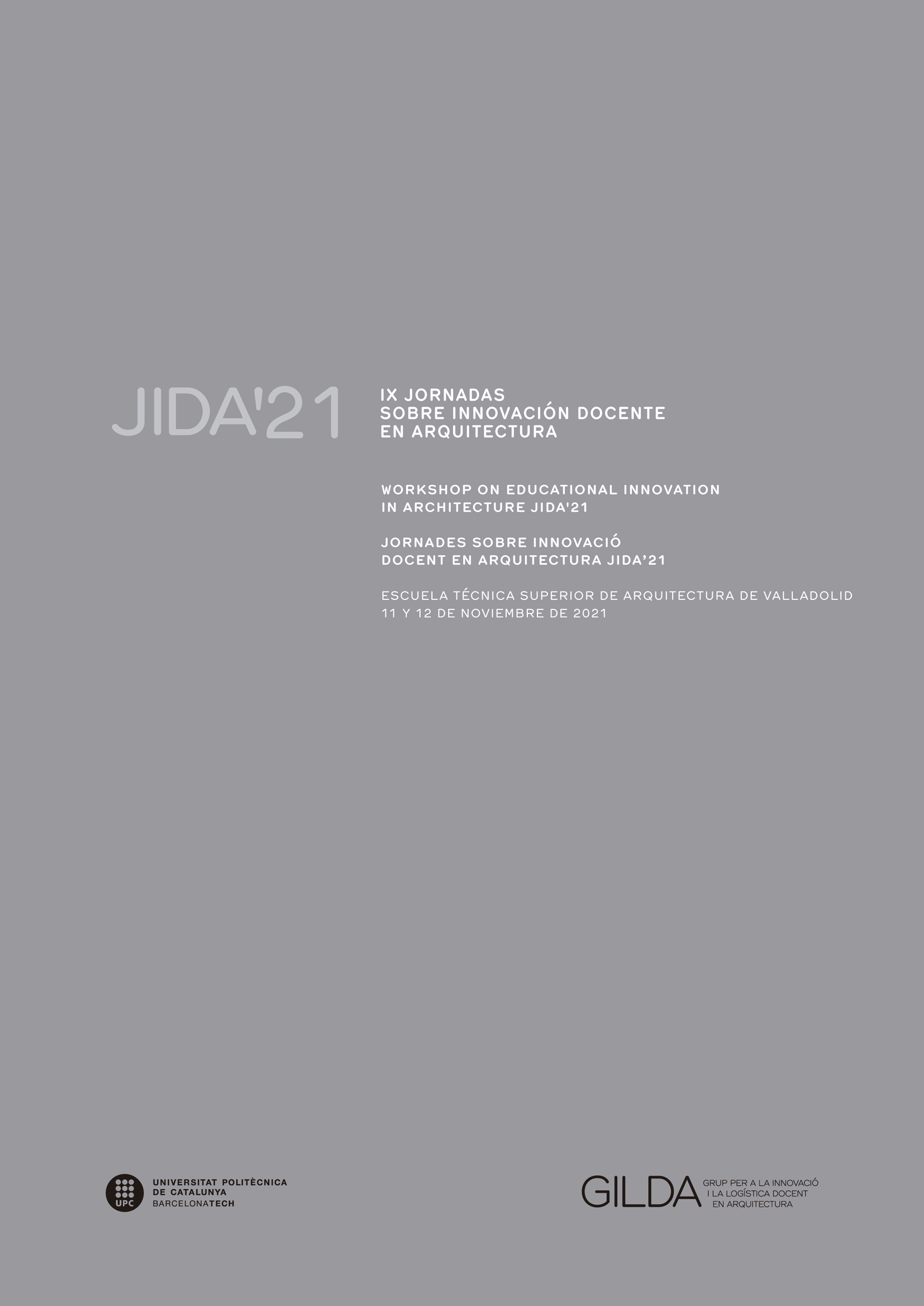Integration of Art-Based Research in Design Curricula
DOI:
https://doi.org/10.5821/jida.2021.10533Keywords:
art, design, disciplinarity, materiality, authorship, projective criticality, agency of matter, strategies of indeterminacyAbstract
This paper focuses on the use of art-based research to enrich active methodologies in design curricula. Based on the analysis of two case studies, it argues the need to further explore a hybridisation of methodologies and disciplines to foster disruptive and innovative design practices within academic programmes in the expanded architectural field. The case studies articulate temporary spatial design with artistic practices through a radical approach to materiality, which is posited as the starting point for each project. Rather than seeing materiality as a second-tier decision addressed after a design concept has been formulated, materials are tackled directly, and the working process then defines the design concept and its detailed resolution. A crucial result of the case studies is the active enactment of new forms of authorship, straddling the space between the autarkic author of post-romantic models and the dissolution of authorship of some contemporary collaborative models.
References
ALLEN, S. (2000). Practice: Architecture, Technique and Representation. Abingdon, OX: Routledge.
AWAN, N.; SCHNEIDER, T.; and TILL, J. (2011). Spatial Agency. Other Ways of Doing Architecture. London and New York: Routledge.
BARAD, K. (2003). “Posthumanist performativity: Toward an understanding of how matter comes to matter” in Signs: Journal ofWomen in Culture and Society, 28(3), p. 801-831.
BENNETT, J. (2010). Vibrant Matter: A Political Ecology of Things. Durham and London: Duke University Press.
BERNSTEIN, J. (2015). “Transdisciplinarity: A Review of Its Origins, Development, and Current Issues” in Journal of Research Practice, 11(1).
CARLILE, P.R. et al. (2013). “How Matter Matters: Objects, Aftifacts, and Materiality in Organization Studies” in Carlile, P. R. et al. (eds) How Matter Matters. Objects, Artifacts and Materiality in Organization Studies. Oxford, UK: Oxford University Press.
DANVERS, J. (2003). “Towards a radical pedagogy: Provisional notes on learning and teaching in art & design” in International Journal of Art and Design Education, 22(1), p. 47-57. doi: 10.1111/1468-5949.00338.
DELL, C. (2019). The Improvisation of Space. Berlin: Jovis.
DEUTSCHE, R. (1996). Evictions: Art and Spatial Politics. Cambridge, MA: The MIT Press.
DILLON, P. and HOWE, T. (2007). “An epistemology of presence and reconceptualisation in design education”, Interchange, 38(1), p. 69-88. doi: 10.1007/s10780-007-9013-4.
FRASER, N. (2014). “Behind Marx”s Hidden Abode: For an Expanded Conception of Capitalism” in New Left Review, 86, pp. 55-72.
GHERARDI, S. and PERROTTA, M. (2013). “Doing by Inventing the way of Doing: Formativeness as the Linkage of Meaning and Matter.” in Carlile, P. R. et al. (eds) How Matter Matters. Objects, Artifacts and Materiality in Organization Studies. Oxford, UK: Oxford University Press, p. 227-260.
GIDDENS, A. (1984). The Constitution Of Society: Outline of the Theory of Strcuturation. Berkley: University of California Press.
HARAWAY, D. (1988). “Situated Knowledges: The Science Question in Feminism and the Privilege of Partial Perspective" in Feminist Studies, 14(3), p. 575-599. doi: 10.2307/3178066.
HICKMAN, R. ed. (2008). Research in Art & Design Education: Issues and Exemplars. Bristol & Chicago: Intellect.
HINSON, D. (2007). “Design as Research: Learning from Doing in the Design-Build Studio” in Journal of Architectural Education, 61 (1), p. 23-26.
JOKELA, T. and HUHMARNIEMI, M. (2018). “Art-based action research in the development work of arts and art education” in Coutts, G.; Hárkönen, E.; Huhmarniemi, M. and Jokela, T. The Lure of Lapland. Rovaniemi: University of Lapland.
LATOUR, B. (2005). Reassembling the Social. An Introduction to Actor-Network-Theory. New York: Oxford University Press.
MAIZ, I. and MÜLLER, M. (eds) (2010). Joseph Beuys: Parallelprozesse. Düsselfdorf: Kunstsammlung Nordrhein-Westfalen.
MÄKELÄ, M.A. and LÖYTÖNEN, T. (2015). “Enhancing material experimentation in design education” in LearnxDesign, The 3rd International Conference for Design Education Researchers. Chicago, Illinois.
MORTON, T. (2017). Humankind. Solidarity with Nonhuman People. London and New York: Verso.
ORTEGA, L. (2017). The Total Designer. Authorship in Architectutre in the Post-digital Age. New York, Barcelona: Actar Publishers.
PAEZ, R. (2019a). Operative Mapping: Maps as Design Tools. New York and Barcelona: Actar Publishers.
PAEZ, R. (ed.) (2019b). Només Paper. Barcelona: Cercle Artístic Sant Lluc.
PAEZ, R. (In press). “Design as Playground: Exploring Design Through Game-based Formats” in Space and Culture, special issue: Cities as Playgrounds/Playgrounds as Cities: Rethinking Urban Play, Civic Engagement and Socio‐Spatiality.
PAEZ, R. and VALTCHANOVA, M. (2021). “Harnessing Conflict: Antagonism and Spatiotemporal Design Practices”, Temes de Disseny, 37 Invisible Conflicts: The New Terrain of Bodies, Infrastructures and Communication, p. 182-213. doi: 10.46467/TdD37.2021.182-213.
RENDELL, J. (2006). Art and Arcitecture: A place Between. London: I.B.Tauris.
SOMOL, R. and WHITING, S. (2002). “Notes around the Doppler Effect and Other Moods of Modernism” in Perspecta 33, p. 72-77. doi: 10.2307/1567298.
TURPIN, E. (ed.) (2014). Architecture in the Anthropocene: Encounters Among Design, Deep Time, Science and Philosophy. Ann Arbor, MI: Open Humanities Press.
WALDHEIM, C. (2006). “Strategies of Indeterminacy in Recent Landscape Practice” in Public, 33 (Errata), p. 80-86. Available at: http://pi.library.yorku.ca/ojs/index.php/public/article/viewFile/30088/27649.
ZAMENOPOULOS, T. and ALEXIOU, K. (2018). “Co-Design As Collaborative Research.” in Connected Communities Foundation Series. Bristol: Bristol University/ AHRC Connected Communities Programme.






















